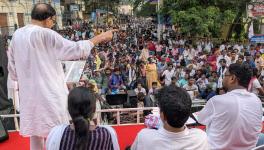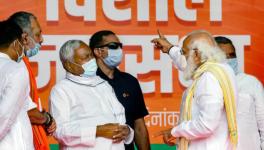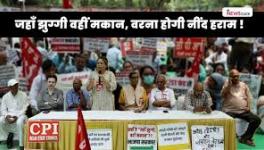Gujarat Elections: Will Meltdown in Surat’s Textile Industry Hurt BJP’s Prospects?
Surat (Gujarat): High inflation, price rise of raw materials, Goods and Services Tax (GST), coupled with the COVID-19 pandemic, have been hitting hard Surat’s synthetic textile industry — which is faced with the worst phase of demand falls. And it will likely impact the ruling Bharatiya Janata Party’s (BJP’s) prospects in the upcoming Assembly elections in Gujarat.
The industry recorded a 60% decline to Rs 8,000 crore in retail demand during this year’s Diwali festive season, according to the Federation of Surat Textile Traders Association (FOSTTA), which said the fabric sector in the city had clocked a business of Rs 16,000 crore last year during the same period.
The industry comprises various verticals: spinning polyester yarn and weaving grey clothes, which are then dyed, processed and embroidered. Textile traders, also called merchant manufacturers, buy the grey clothes woven at power looms and get them dyed, processed, and the embroidery works done before selling them to wholesalers across the country.
Jignesh Vataliya, 35, has 38 computerised or automatic embroidery machines in his workshop at Diamond Nagar in Kamrej — a satellite town of Surat city — where 75 workers used to work throughout the year. Because of the heavy rush of work orders, especially during festive seasons, the workers used to get off for a day or two on the festive occasion of Diwali.
But the situation is not same for the past two years. His workshop has begun functioning for the past few days after Diwali, and the workload he has right now will last for the next two-three days. Will he get the next order? He is not sure about it.
Of the 38 machines, only six have been made operational. The rest are lying idle as there is no work. Of the total workforce of 75, he fired 61 workers this year as he has run out of funds and cannot pay them anymore without work.
Ten members of his family were in the same business, but seven of them have brought down shutters. Some have now started working in textile mills as employees and the rest are searching for a job.
The meltdown in the textile sector has caused a massive lay-off of labourers. Of the one lakh labourers, around 35,000 have already lost their jobs. And if this continues, more people will be left jobless.
Estimates suggest that around 45,000 to 50,000 multi-headed computerised embroidery machines in Surat are operated by the same number of labourers who work in two shifts.
“Night shifts in the embroidery units have completely stopped because of a fall in orders,” said Devkishan Mungani, General Secretary of the Federation of Surat Textiles and Traders’ Association.
Jignesh is still surviving because he is counted among one of the top 10 players in Surat’s embroidery industry.
“With the 70-80% decline in the business, my annual income has gone down to just 10%. We are not getting work orders from traders who are abandoning the work to shift to other sectors because of the new tax regime, skyrocketing prices and lesser returns,” he told NewsClick.
Explaining how the industry is fast losing its sheen, he said every manufacturer used to have bulk orders since Diwali (which the traders and manufacturers here consider the beginning of their new business year). The workload was such that no one used to get enough time to even talk to their families. But this year, even after almost a month since the festival, most factories are shut because they do not have work from the traders.
“Despite extremely slow demands last year, I did not fire any of my designers or workers and managed to pay their salaries. When nothing changed this year, I failed to afford the expenses and had to laid off my staff even though it was a very tough decision to make as many of them had been working with me for years and even decades. The work pressure is so low that only six machines are functioning. I got the first work order of this business year a week back, and it will be finished in a couple of days. I have no idea as to what will happen after that,” he narrated.
Vijaybhai Patel has four machines in his embroidery manufacturing unit at Matavadi in Varachha. The factory was closed since Diwali before it got the first work order of this business year only four days back.
“Ideally, the industry should have started functioning three days after the Diwali vacation. But it is closed even after a month. Right now, I have work for four days. If more orders come in, the unit will keep operating; otherwise, I will have to shut it again,” he said, adding that despite having a small unit, he too has to downsize the team of workers.
He said one machine should be manned by at least two staff. But because of a fund crunch, two machines are handled by one worker.
Following years of struggle, Monty Manghani, 37, achieved success in 2017 when the annual revenues from his trading unit in Surat were nearing Rs 1 crore.
But the rollout of the GST from July 1 of that year shattered all his dreams as the new tax regime brought a challenge for him. As a result, he had to shut his shop and start working with his father, a merchant manufacturer. The annual turnover of the father-son duo’s joint business is nearly Rs 2 crore.
“The traders must pay taxes and account for the same at each stage. Unlike in the pre-GST era, a sole entrepreneur, working informally, cannot do so. The predominantly informal business sector of synthetic fabrics continues to bear the brunt of the new taxing system. While the government claims to have boosted the tax revenue and formalised India’s economy, the reality is Surat cluster is unable to pay these taxes and remain competitive,” he said.
The Surat textile industry fiercely opposed the decision, with the manufacturers and traders petitioning the government several times. When they failed to deliver desired results, they went on strike in mid-June 2017. But it also failed to bring any relief. A massive police crackdown was launched, and the strike petered out.
HOW THE INDUSTRY FUNCTIONS
Two value chains co-exist in the Surat cluster. The first comprises thousands of small units engaged in garment manufacturing — some units make yarn and others weave it into the fabric. Many of them print, stitch and embroider the garment.
More than 70,000 textile traders play a pivotal role in this arrangement. They take orders from textile and garment sellers and lead the consignment from unit to unit along the manufacturing process. It is a competitive value chain where thousands of small businessmen, who are operating their units with the help of migrant workers, compete with each other for business.
The textile industry in India is estimated to be worth Rs 30,000 crore. Exports contribute about Rs 800 crore. Embroidery forms a major part of the ready fabric industry. Earlier, the traders used to export embroidered fabrics to countries such as Great Britain, the United States of America and the United Arab Emirates.
The other value chain is integrated and organised. It has large companies which do everything — from weaving to post-production in-house. But not even 10 such firms exist in Surat. Most units in the cluster operate in the disaggregated value chain.
The GST has impacted both of these value chains.
HOW GST IS HURTING
In this taxation system, the government levies tax at every step along the value chains instead of the final production. And every firm in the value chain has to pay tax on the value it adds. For example, a manufacturer buys polyester yarn for Rs 100 and sells the product (a saree or any other garment) for Rs 150; it has to pay 5% GST on Rs 50 (the added value — turning yarn into a garment), which works out to Rs 2.5.
But here is a catch. While the finished product attracts a GST of 5%, polyester yarn is taxed 18%.
“When I buy yarn worth Rs 100, I pay Rs 18 as tax. As per 5% GST on the final product, I should have paid only Rs 2.5. I am entitled to get a refund of Rs 18. However, when I sell the finished garment at Rs 150, the buyer pays 5% (Rs 7.5) as GST. So, at max, I can get a refund of Rs 10.5. I can get the surplus through a claim. The government keeps the rest of the money,” explained the managing director of a large sari-manufacturing company in Surat’s Pandesara who did not wish to be identified.
But, he said, this is not how it works. If all this is put together, he said, then only one can realise how the GST is hurting the industry. “It is changing the cost structure of the value chains, consumers’ behaviour and competitors’ profile,” he explained.
The weavers could not avail of the input tax credit refund. This was allowed in 2018. However, even today, refund applications take 6-8 months to be processed, which is why industry players prefer not to apply for refunds.
The corridors of the city’s textile markets have not been as hustle and bustle as they used to be five years back. It is deserted and quieter.
“Pahle ka 50 taka bhi kaam nahin hai (there is not even 50% of the earlier business). Orders have dried up,” a trader in his early 40s told NewsClick.
Buyers from Bihar, Uttar Pradesh, Maharashtra and Jharkhand, who used to travel to Surat to buy garments against cash, have stopped coming because of harassment at the hand of the police, who demands GST bills from them for transporting the consignment, he said.
From where are they purchasing now? “They are buying locally as big garment manufacturers in Surat have their offices in other states,” he said and also added local transporters buy stocks without bills and sell them in neighbouring states.
In any case, he said, the traders are at the receiving end as their volume has fallen flat.
However, few argue that the GST is good for the industry as it has “formalised” the operations across the value chain.
“The new tax regime has made it easier for us to apply for loans or schemes as it has brought legitimacy to our businesses. The only drawback is that not many small and sole entrepreneurs could survive the GST implementation,” said Monty.
Since traders are directly impacted, small units — which get work from the traders — face the heat.
All this happens when the industry has not recovered completely from demonetisation. “Pahle notebandi, uske baad GST, phir COVID aur ab mongwari (the demonetisation was followed by the implementation of the GST, then the COVID pandemic and now the high inflation). We are trapped in between,” said Jignesh, adding that the profit margins have come to an all-time low because of the hike in prices of raw materials and stagnant rates of the consignments.
The industry players said the textile cluster in Surat had been hit in terms of tax rates and structure since everything from raw materials to finished products is attracting a different tax rate.
For example, 18% GST is levied on raw materials like polyester partially oriented yarn (POY) has c, but when turned into texturised yarn, the same saw a change in the rate, from 18% to 12%, in the first year of the new tax regime.
CONSOLIDATION OF BUSINESSES
Surat’s textile industry has also been witnessing consolidation of weavers and merchant manufacturers (textile traders) because the small players have failed to survive the GST regime.
Champalal Bothra, general secretary of the FOSTTA who had also led the GST Sangharsh Samiti in 2017, said the industry had around 70,000 merchant manufacturers before the GST era. However, GST, coupled with the COVID-19 pandemic, led to their consolidation, bringing down their number to around 45,000-50,000.
“Most of the existing merchant manufacturers have a turnover of between Rs 25 crore and Rs 100 crore. The ones with lesser turnover failed to survive,” he adds.
However, Devkishan Manghani, advisor to the textile trade committee of the South Gujarat Chamber of Commerce and Industry (SGCCI), said, “This is happening because grey cloth is bought from weavers and then, it is sent for processing, and other works such as dyeing, bleaching, lacing and embroidery before selling the finished goods as sarees, dress materials, top wear and bottom wear garments to wholesalers.”
Bodhran and many others were forthright, claiming that the business community will not let these go as it is in the upcoming elections and that the BJP will face the heat. They said except for the Jain and Marwari voters; others seem to have shifted their loyalties to the debutant Aam Aadmi Party (AAP), which has emerged as a ray of hope for them.
Surat has been a stronghold of the saffron party, which won all 12 seats in the 2017 Assembly elections. But this time, the party faces difficulties doing door-to-door campaigns in different pockets because of large-scale resentment among people.
Get the latest reports & analysis with people's perspective on Protests, movements & deep analytical videos, discussions of the current affairs in your Telegram app. Subscribe to NewsClick's Telegram channel & get Real-Time updates on stories, as they get published on our website.
























